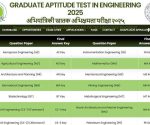Why are America’s prestigious universities falling prey to “Math crisis”? – The Times of India

A troubling reality is painting the walls of America’s elite institutions. Once considered synonymous with intellectual prowess, these universities are now witnessing a starting challenge: Students entering the gates of college are lacking basic mathematical skills. A recent post shared by Stripe CEO and Arc Institute co-founder Patrick Collison echoed as a wake-up call and reverberated through the corridors of American education. The post revealed that an MIT math professor had noted a significant decline in the mathematical proficiency of incoming students. It also mentioned that Harvard has initiated remedial math courses to assist students in bridging the gap in essential algebraic expressions.
What was once a muted concern has now amplified into a full-fledged crisis. The institutions that have long garnered recognition for imparting top-notch academic excellence and attracting the brightest minds across the globe, this move does not signal a minor hiccup but a systemic failure in preparing students for the rigours of higher education in mathematics. The very foundation of academic foundation seems to be fractured, and the repercussions on the future of education are profound.
The symptoms of a widespread problem
While concerns about declining math standards have been voiced for years, the introduction of remedial courses at the prestigious Harvard University adds weight to the problem that even the top echelon of students is being impacted. If the best of the best are grappling with the results, what does this say about the broader picture of American education?
Studies have long indicated a downward trend in math proficiency among US students. The latest National Assessment of Educational Progress (NAEP) 2024 report offers a stark reality: Only 33% of eighth-graders are proficient in math, a significant dip from 41% in 2017.
The report paints a concerning picture of math proficiency in the US. The decline is particularly pronounced among Black and Hispanic students, with only 13% and 17% demonstrating proficiency, respectively. Low-income students are also struggling, with only 12% meeting proficiency standards, compared to 39% of their wealthier peers.
Internationally, US students have dropped from 30th place in 2018 to 34th place in 2023 in the Programme for International Student Assessment (PISA) rankings, highlighting the nation’s growing vulnerability in global education comparisons.
What is causing the decline?
America’s elite universities are witnessing a downward trend: The need for remedial math programs is becoming increasingly rampant. Once, institutions like MIT and Harvard accepted students with robust math foundations, but now, many incoming freshmen are unable to meet the basic requirements for college-level math courses. This has led to the introduction of remedial courses, such as Harvard’s Math MA5, aimed at addressing gaps in fundamental algebra skills. What is making these esteemed educational institutions lose their shine?
Concepts vs. calculation tactics
In recent years, the emphasis of math education has shifted from mastering specific problem-solving skills to a more abstract, conceptual understanding of mathematical ideas. While this transition has benefits, it has inadvertently left many students without the necessary skills to apply these concepts in practical situations. The top universities now face students who discuss mathematical theories but grapple with basic calculations or procedural tasks. The focus on conceptual learning, while important, must be balanced with a strong foundation in the mechanics of mathematics if students are to succeed in higher education.
High reliance on technology is weakening the education system
The over-reliance on calculators, software, and other digital tools in education has raised concerns about students’ ability to perform basic mathematical functions manually. While technology offers valuable tools for complex calculations, it can impede students’ ability to cultivate essential arithmetic skills. Students are increasingly dependent on their devices, unable to do simple calculations in their minds. The extreme dependence on technology has augmented the challenge for top universities, which now see their best students lacking fundamental skills needed for rigorous math coursework.
Fractures in foundation lead to weakened higher education
The quality of K-12 math education plays an instrumental role in determining students’ preparedness for higher education. Over the years, numerous shifts in curriculum and educational standards have led to inconsistencies in math instruction nationwide. In some areas, schools have struggled to maintain high standards for math education, and students are promoted to higher levels without fully grasping the foundational concepts. By the time these students reach prestigious universities, their lack of preparedness becomes evident. A solid math foundation, built in the earlier years of education, is pivotal for success at the college level.
Pandemic learning loss: A compounding factor
The COVID-19 pandemic has massively impacted the education system, and its effects on math education are highly pronounced. Remote learning, which became “new normal” during the pandemic, has affected the foundation of academics in numerous ways. It has often failed to effectively cater to the hands-on, step-by-step nature of math instruction. As a result, students missed out on key lessons, including those entering top universities, with critical gaps in their math knowledge. This disruption has further fanned the flames of the math crisis in higher education.
Focus on scores, mastery is sidelined
Learning for acquiring marks rather than gaining knowledge is one of the significant factors reversing the course of academic success. Standardized testing has long cemented the education system, especially for college admissions. However, critics contend that these tests prioritize test-taking strategies over true mastery of subjects like math. As a result, students focus more on preparing for the test format rather than developing deep understanding and problem-solving skills. This emphasis on test scores has led to a system where students are “trained” to pass exams but are not necessarily equipped to handle the rigorous math requirements of top universities.
Disconnect between high school and college math standards
One of the key issues driving the math crisis in elite universities is the disconnect between high school and college math standards. In many cases, high school math curricula do not align with the demands of college-level courses. While some students may excel in high school math, they find themselves unprepared for the increased complexity of university math.
As American education finds itself shackled in the crisis, the question remains: Can the education system recalibrate before the damage becomes irreparable? The decline in foundational skills is not just a sign of academic failure—it’s a warning of a future where innovation and critical thinking are compromised. Without urgent, systemic reform, the very pillars of higher education could crumble under the weight of its own neglect.
















